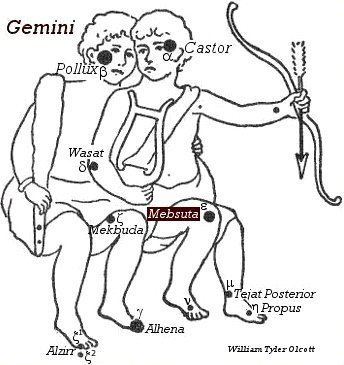Magnitude 3.06 Apparent magnitude (V) 3.06 | ||
 | ||
Similar Zeta Geminorum, Delta Geminorum, Mu Geminorum, Eta Geminorum, Gamma Geminorum | ||
Epsilon Geminorum (ε Geminorum, abbreviated Epsilon Gem, ε Gem), also named Mebsuta, is a star in the constellation of Gemini and is located on the outstretched right 'leg' of the twin Castor. The apparent visual magnitude of +3.06 makes it one of the brighter stars in this constellation.
Contents
The distance to this star can be determined directly using parallax measurements, yielding a value of 840 light-years (260 parsecs), although this result has a relatively large margin of error of 40 ly (12 pc). Because Epsilon Geminorum is located near the ecliptic it can be occulted by the Moon or a planet. Just such an occultation took place on April 8, 1976 by Mars, which allowed the oblateness of the planet's outer atmosphere to be measured. Prior to that, the star was occulted by Mercury on June 10, 1940. On September 3, 2015, Epsilon Geminorum is expected to be occulted by the asteroid Iphigenia.
Nomenclature
ε Geminorum (Latinised to Epsilon Geminorum) is the star's Bayer designation. It bore the traditional names Mebsuta, Melboula or Melucta. Mebsuta has its roots in ancient Arabic where it and the star Mekbuda (Zeta Geminorum) were the paws of a lion. Mebsuta ('Mabsūṭah' مبسوطة) comes from a phrase referring to the outstretched paw. In 2016, the International Astronomical Union organized a Working Group on Star Names (WGSN) to catalog and standardize proper names for stars. The WGSN's first bulletin of July 2016 included a table of the first two batches of names approved by the WGSN; which included Mebsuta for this star.
In Chinese, 井宿 (Jǐng Su), meaning Well (asterism), refers to an asterism consisting of ε Geminorum, μ Geminorum, ν Geminorum, γ Geminorum, ξ Geminorum, 36 Geminorum, ζ Geminorum and λ Geminorum. Consequently, ε Geminorum itself is known as 井宿五 (Jǐng Su wǔ, English: the Fifth Star of Well.)
Properties
The spectrum of this star matches a stellar classification of G8 Ib, where the luminosity class of Ib indicates this is a lower luminosity supergiant star. Alternatively, it may be a star that has passed through the asymptotic giant branch stage and possesses a detached shell of dust. The estimated mass of this star is over 19 times the mass of the Sun, and it has expanded to a radius measured at around 105–175 times that of the Sun. Since 1943, the spectrum of this star has served as one of the stable anchor points by which other stars are classified.
Epsilon Geminorum is radiating around 8,500 times the luminosity of the Sun from its outer atmosphere at an effective temperature of 4,662 K. It is this temperature that gives it the yellow-hued glow of a G-type star. A surface magnetic field with a strength of –0.14 ± 0.19 G has been detected on this star. This topologically complex field is most likely generated by a dynamo formed from the deep convection zone in the star's outer envelope.
In culture
USS Melucta (AK-131) was a United States Navy Crater class cargo ship named after the star.
